General Sir John Monash, Personal Files Book 19, 4 June - 24 June 1918, Part 11
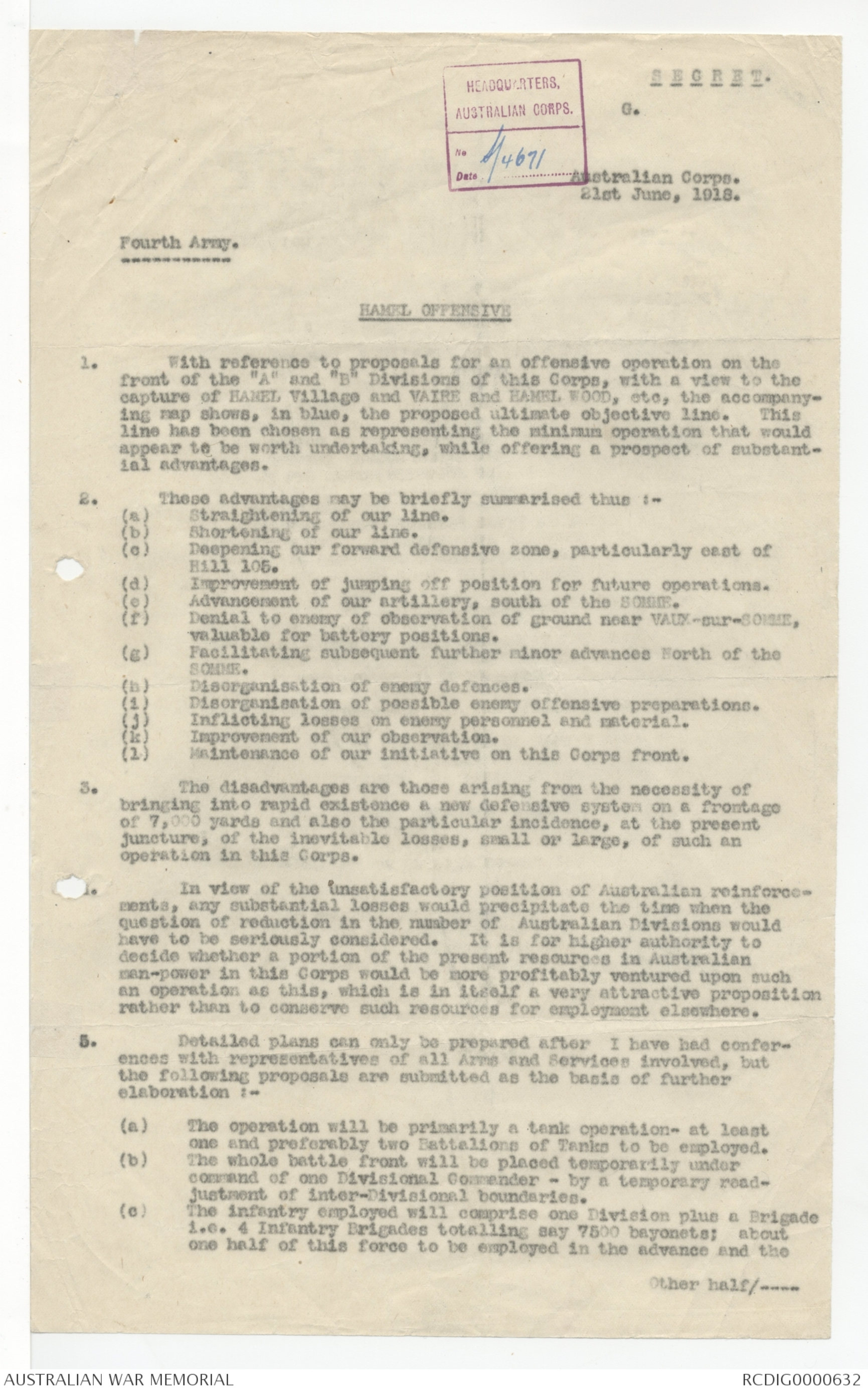
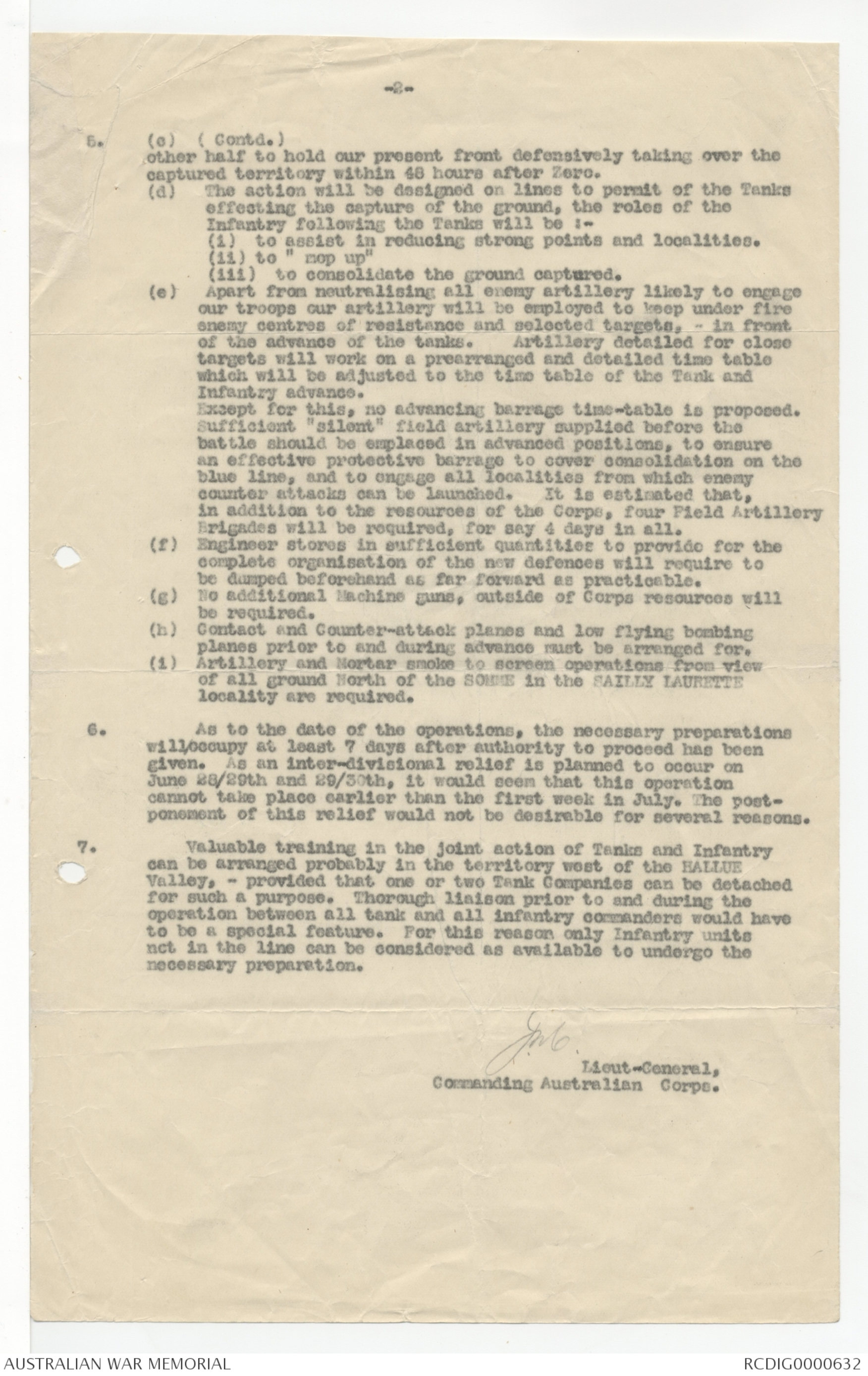
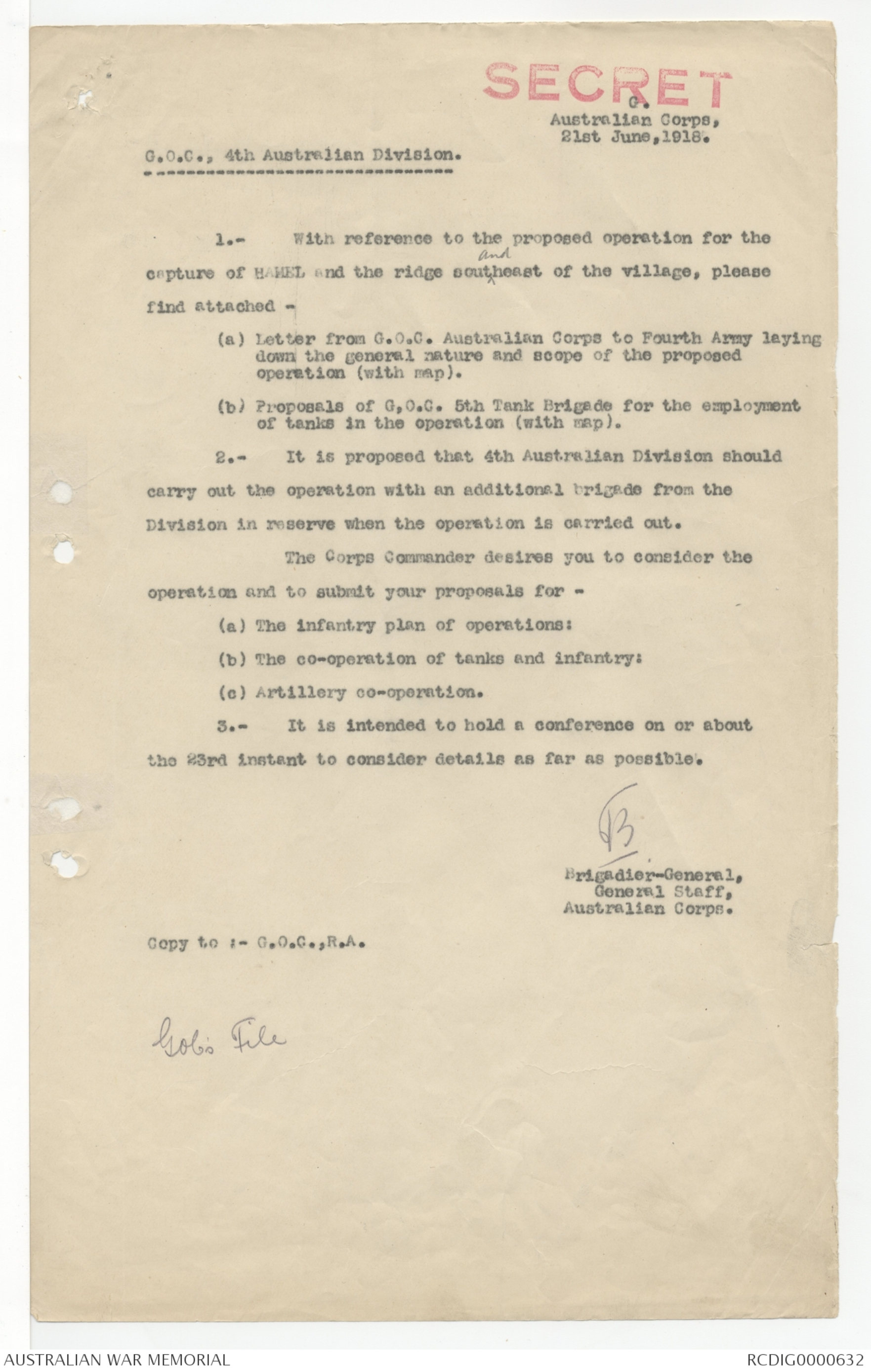
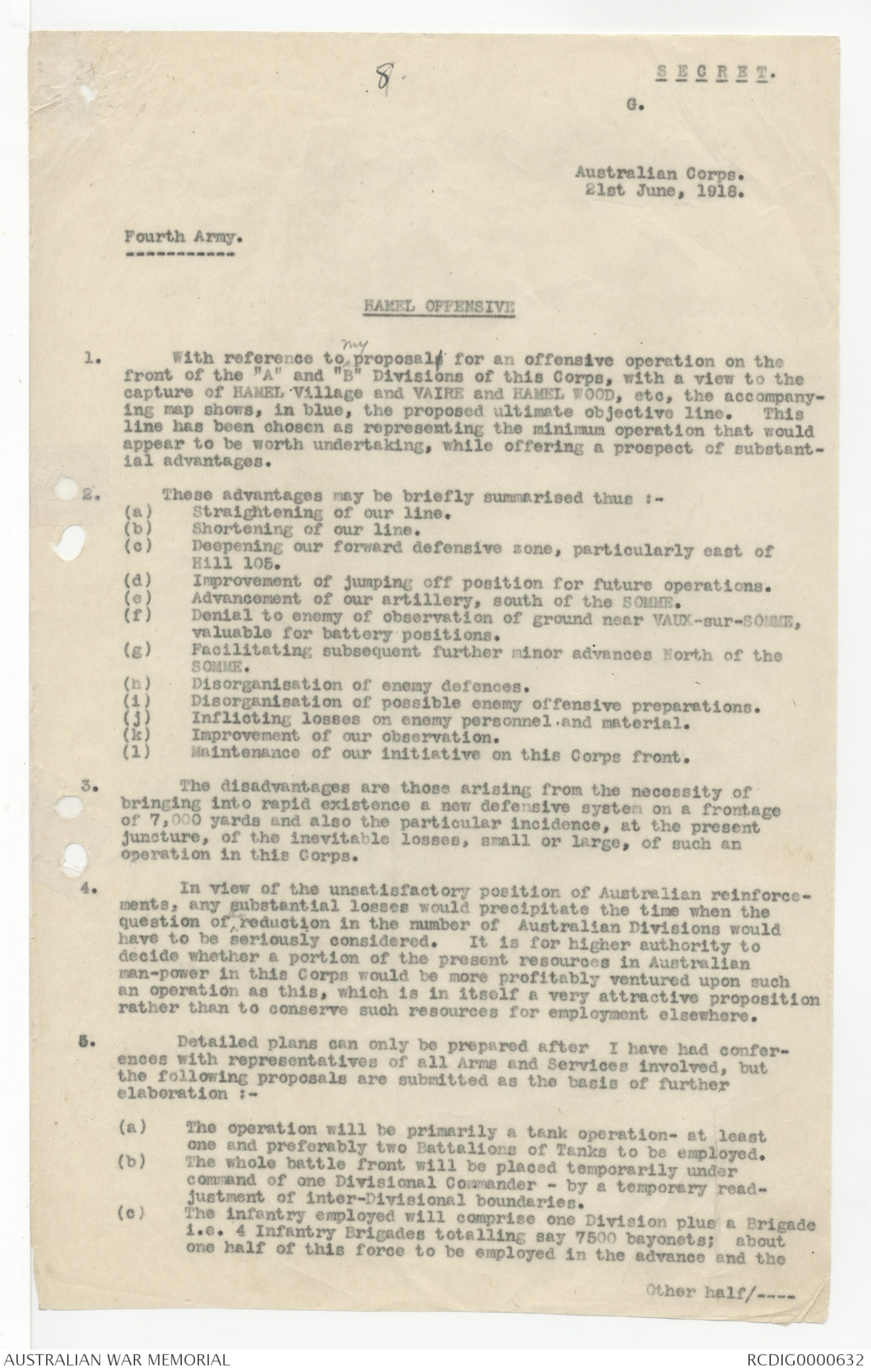
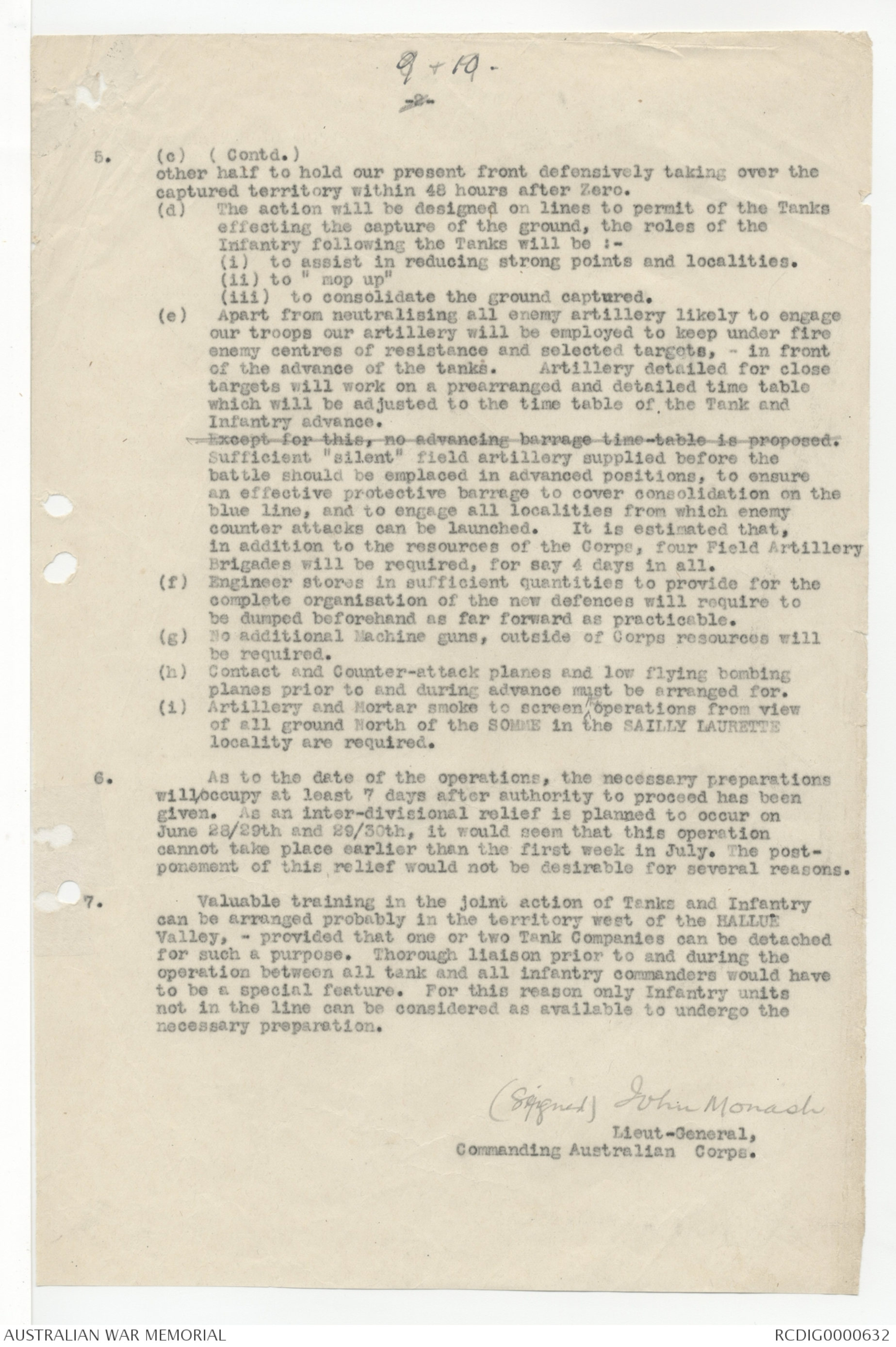
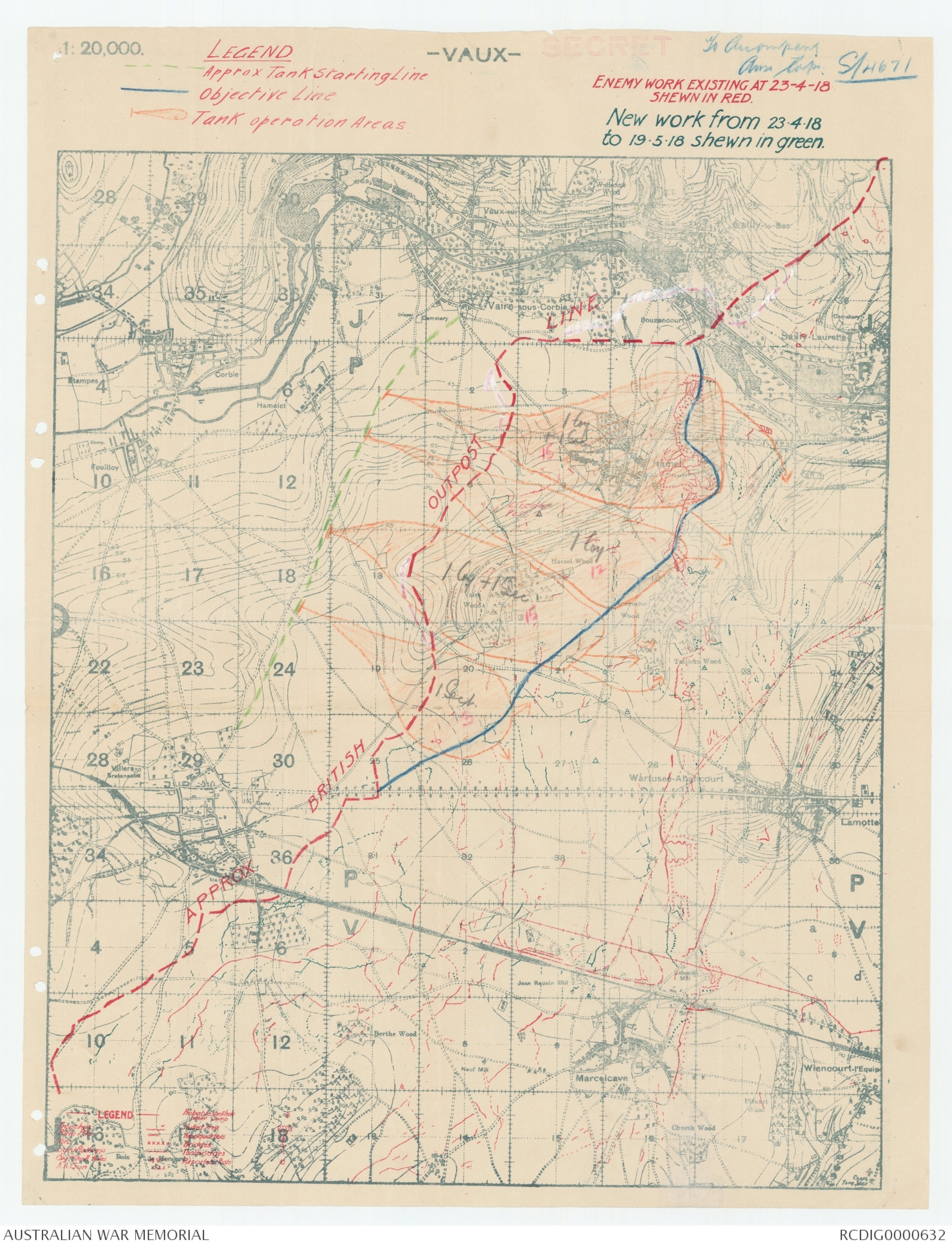
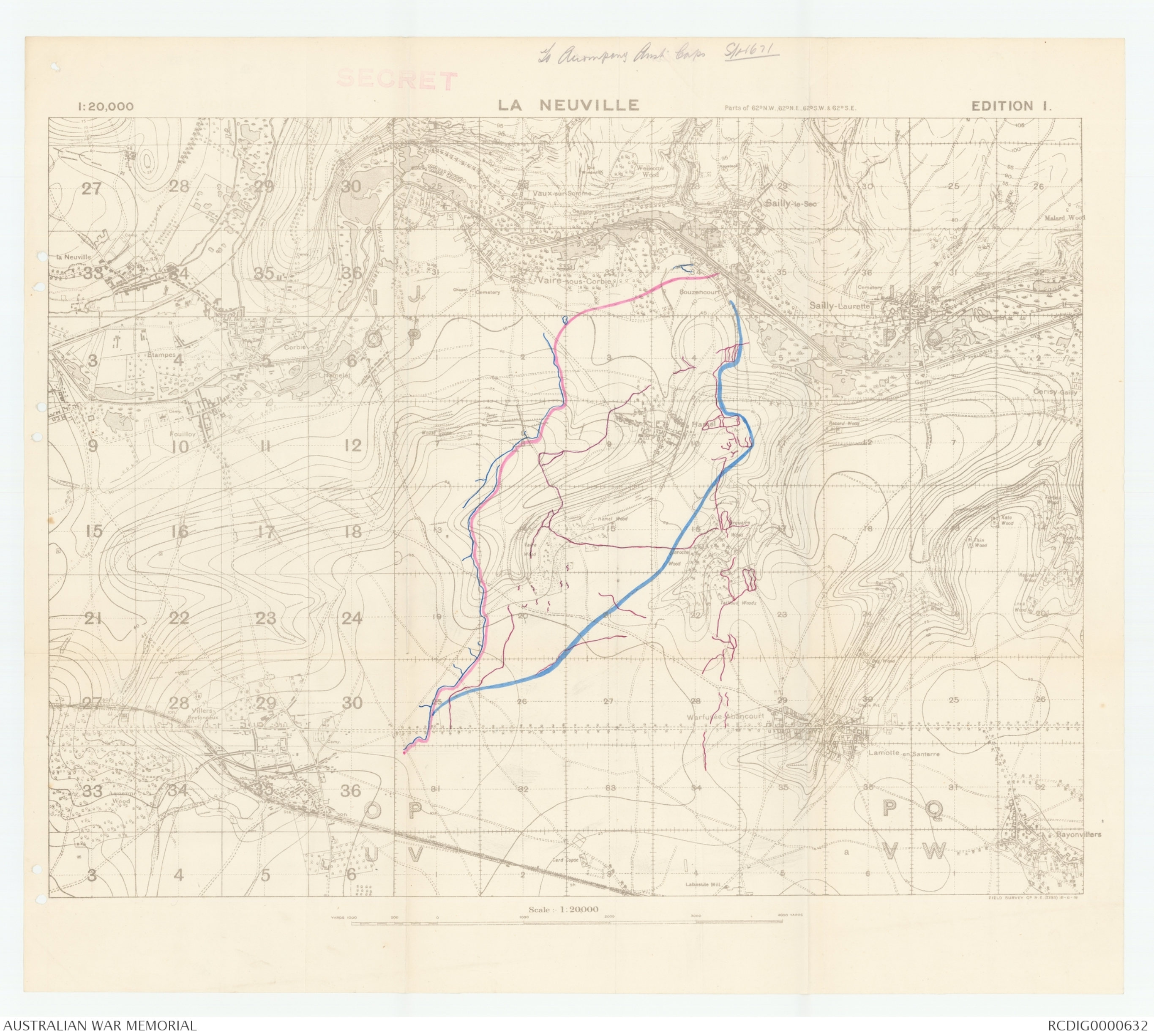
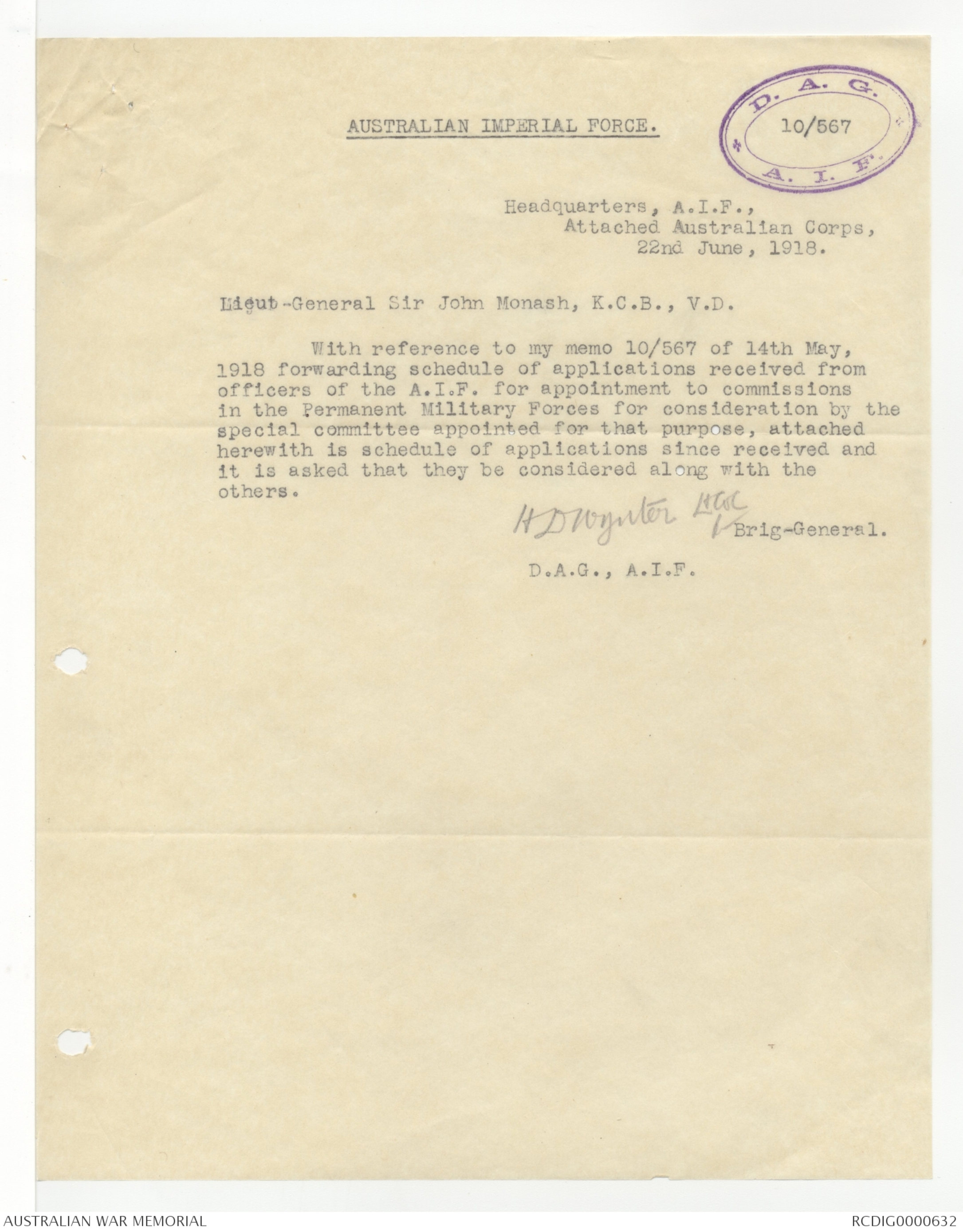
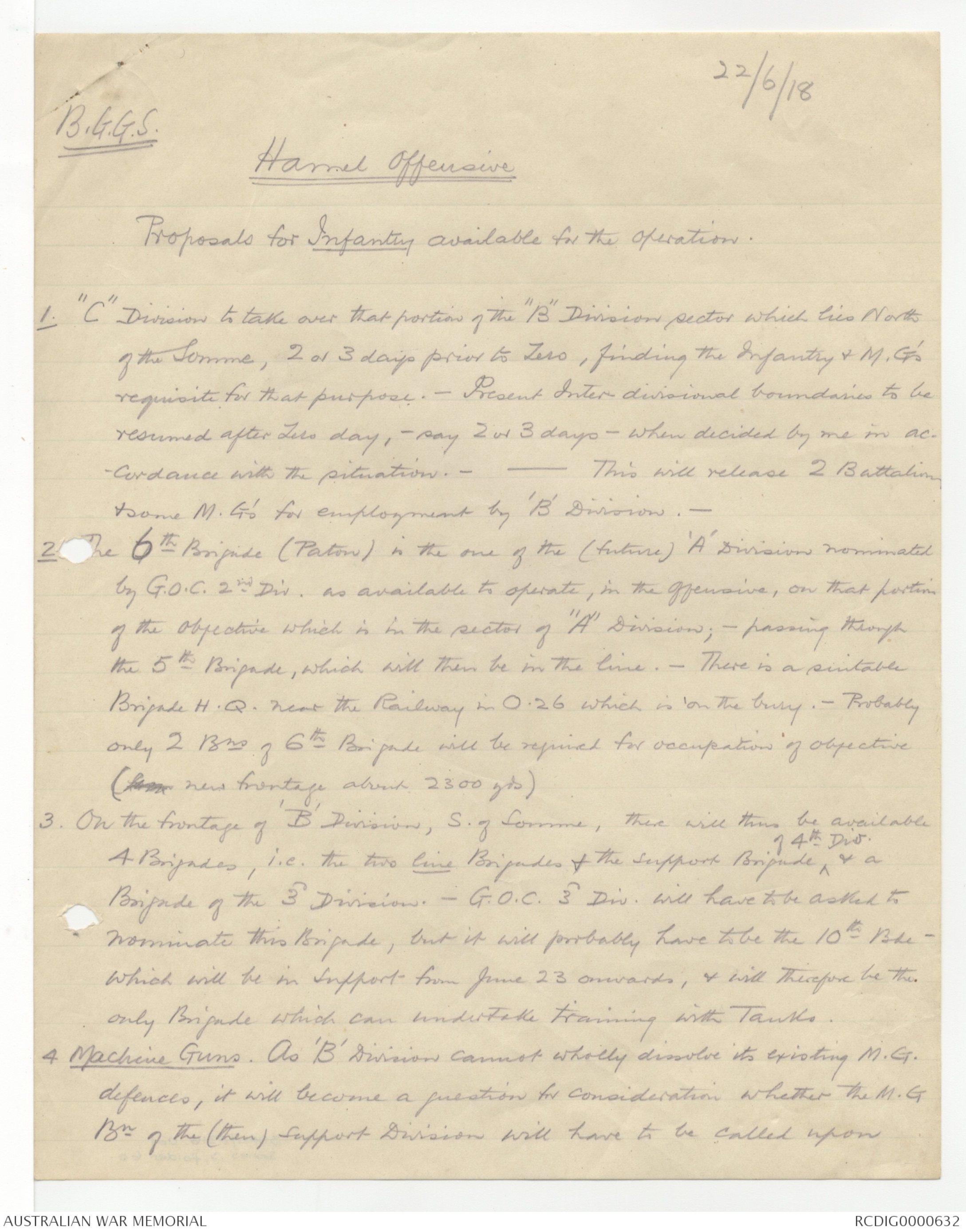
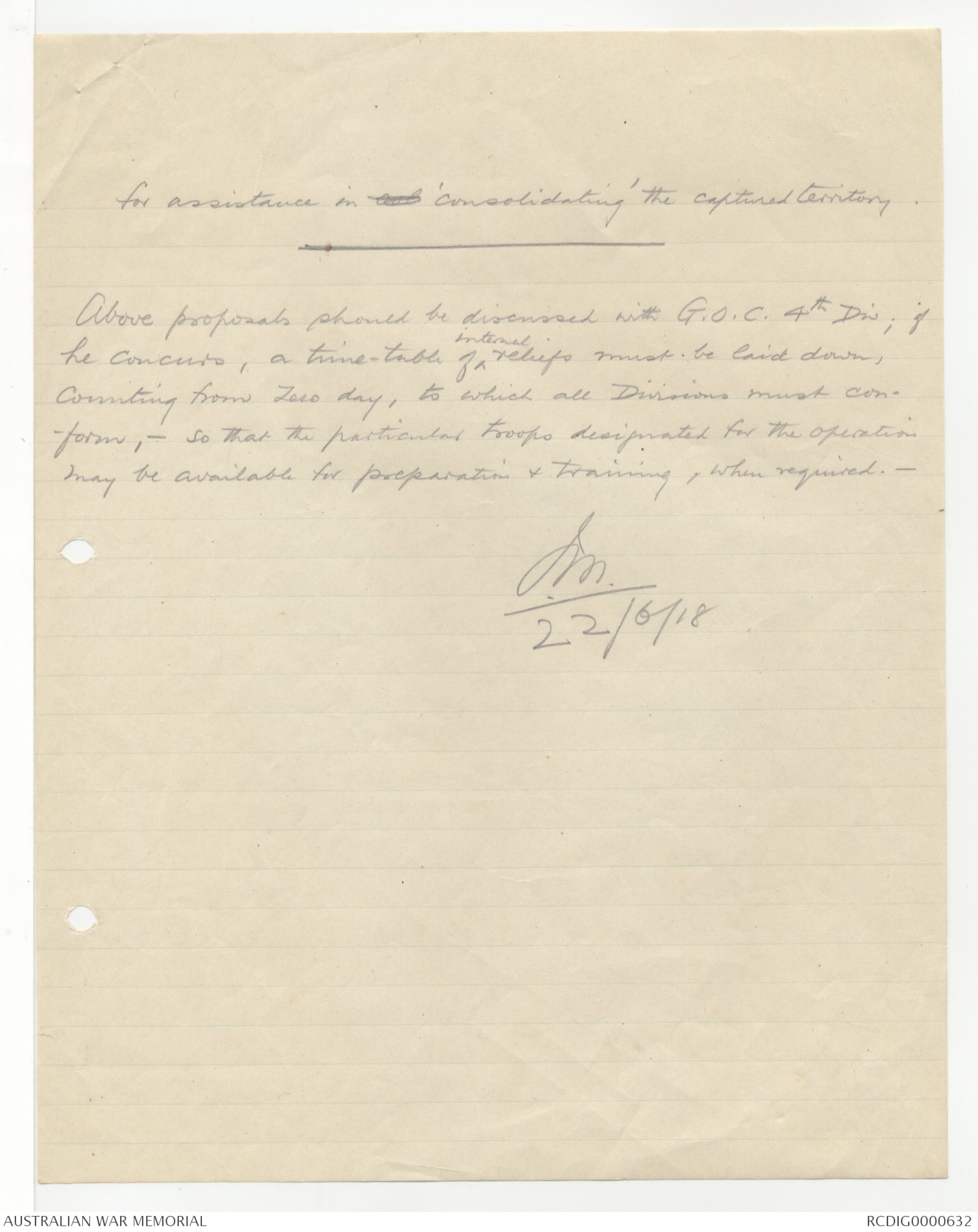
HEADQUARTERS,
AUSTRALIAN CORPS.
No S/4671
S E C R E T.
G.
Australian Corps.
21st June, 1918.
Fourth Army.
HAMEL OFFENSIVE
-
With reference to proposals for an offensive operation on the
front of the "A" and "B" Divisions of this Corps, with a view to the
capture of HAMEL Village and VAIRE and HAMEL WOOD, etc, the accompanying
map shows, in blue, the proposed ultimate objective line. This
line has been chosen as representing the minimum operation that would
appear to be worth undertaking, while offering a prospect of substantial
advantages.
-
These advantages may be briefly summarised thus :-
(a) Straightening of our line.
(b) Shortening of our line.
(c) Deepening our forward defensive zone, particularly east of
Hill 105.
(d) Improvement of jumping off position for future operations.
(e) Advancement of our artillery, south of the SOMME.
(f) Denial to enemy of observation of ground near VAUX-sur-SOMME,
valuable for battery positions.
(g) Facilitating subsequent further minor advances North of the
SOMME.
(h) Disorganisation of enemy defences.
(i) Disorganisation of possible enemy offensive preparations.
(j) Inflicting losses on enemy personnel and material.
(k) Improvement of our observation.
(l) Maintenance of our initiative on this Corps front.
-
The disadvantages are those arising from the necessity of
bringing into rapid existence a new defensive system on a frontage
of 7,000 yards and also the particular incidence, at the present
juncture, of the inevitable losses, small or large, of such an
operation in this Corps.
-
In view of the unsatisfactory position of Australian reinforcements,
any substantial losses would precipitate the time when the
question of reduction in the number of Australian Divisions would
have to be seriously considered. It is for higher authority to
decide whether a portion of the present resources in Australian
man-power in this Corps would be more profitably ventured upon such
an operation as this, which is in itself a very attractive proposition
rather than to conserve such resources for employment elsewhere.
-
Detailed plans can only be prepared after I have had conferences
with representatives of all Arms and Services involved, but
the following proposals are submitted as the basis of further
elaboration :-
(a) The operation will be primarily a tank operation - at least
one and preferably two Battalions of Tanks to be employed.
(b) The whole battle front will be placed temporarily under
command of one Divisional Commander - by a temporary readjustment
of inter-Divisional boundaries.
(c) The infantry employed will comprise one Division plus a Brigade
i.e. 4 Infantry Brigades totalling say 7500 bayonets; about
one half of this force to be employed in the advance and the
Other half/---
5. (c) (Contd.)
other half to hold our present front defensively taking over the
captured territory within 48 hours after Zero.
(d) The action will be designed on lines to permit of the Tanks
effecting the capture of the ground, the roles of the
Infantry following the Tanks will be :-
(i) to assist in reducing strong points and localities.
(ii) to "mop up"
(iii) to consolidate the ground captured.
(e) Apart from neutralising all enemy artillery likely to engage
our troops our artillery will be employed to keep under fire
enemy centres of resistence and selected targets, - in front
of the advance of the tanks. Artillery detailed for close
targets will work on a prearranged and detailed time table
which will be adjusted to the time table of the Tank and
Infantry advance.
Except for this, no advancing barrage time-table is proposed.
Sufficient "silent" field artillery supplied before the
battle should be emplaced in advanced positions, to ensure
an effective protective barrage to cover consolidation on the
blue line, and to engage all localities from which enemy
counter attacks can be launched. It is estimated that,
in addition to the resources of the Corps, four Field Artillery
Brigades will be required, for say 4 days in all.
(f) Engineer stores in sufficient quantities to provide for the
complete organisation of the new defences will require to
be dumped beforehand as far forward as practicable.
(g) No additional Machine guns, outside of Corps resources will
be required.
(h) Contact and Counter-attack planes and low flying bombing
planes prior to and during advance must be arranged for.
(i) Artillery and Mortar smoke to screen operations from view
of all ground North of the SOMME in the SAILLY LAURETTE
locality are required.
-
As to the date of the operations, the necessary preparations
will occupy at least 7 days after authority to proceed has been
given. As an inter-divisional relief is planned to occur on
June 28/29th and 29/30th, it would seem that this operation
cannot take place earlier than the first week in July. The postponement
of this relief would not be desirable for several reasons.
-
Valuable training in the joint action of Tanks and Infantry
can be arranged probably in the territory west of the HALLUE
Valley, - provided that one or two Tank Companies can be detached
for such a purpose. Thorough liaison prior to and during the
operation between all tank and all infantry commanders would have
to be a special feature. For this reason only Infantry units
not in the line can be considered as available too undergo the
necessary preparations.
J.M.
Lieut-General,
Commanding Australian Corps.
SECRET
G.
Australian Corps,
21st June, 1918.
G.O.C., 4th Australian Division.
1. - With reference to the proposed operation for the
capture of HAMEL and the ridge south and east of the village, please
find attached -
(a) Letter from G.O.C. Australian Corps to Fourth Army laying
down the general nature and scope of the proposed
operation (with map).
(b) Proposals of G.O.C. 5th Tank Brigade for the employment
of tanks in the operation (with map).
2. - It is proposed that 4th Australian Division should
carry out the operation with an additional brigade from the
Division in reserve when the operation is carried out.
The Corps Commander desires you to consider the
operation and to submit your proposals for -
(a) The infantry plan of operations:
(b) The co-operation of tanks and infantry:
(c) Artillery co-operation.
3. - It is intended to hold a conference on or about
the 23rd instant to consider details as far as possible.
JB
Brigadier-General,
General Staff,
Australian Corps.
Copy to :- G.O.C.,R.A.
[*GOC's File*]
8.
S E C R E T
G.
Australian Corps.
21st June, 1918.
Fourth Army.
HAMEL OFFENSIVE
-
With reference to ∧my proposal
sfor an offensive operation on thefront of the "A" and "B" Divisions of this Corps, with a view to the
capture of HAMEL Village and VAIRE and HAMEL WOOD, etc, the accompanying
map shows, in blue, the proposed ultimate objective line. This
line has been chosen as representing the minimum operation that would
appear to be worth undertaking, while offering a prospect of substantial
advantages.
-
These advantages may be briefly summarised thus :-
(a) Straightening of our line.
(b) Shortening of our line.
(c) Deepening our forward defensive zone, particularly east of
Hill 105.
(d) Improvement of jumping off position for future operations.
(e) Advancement of our artillery, south of the SOMME.
(f) Denial to enemy of observation of ground near VAUX-sur-SOMME,
valuable for battery positions.
(g) Facilitating subsequent further minor advances North of the
SOMME.
(h) Disorganisation of enemy defences.
(i) Disorganisation of possible enemy offensive preparations.
(j) Inflicting losses on enemy personnel and material.
(k) Improvement of our observation.
(l) Maintenance of our initiative on this Corps front.
-
The disadvantages are those arising from the necessity of
bringing into rapid existence a new defensive system on a frontage
of 7,000 yards and also the particular incidence, at the present
juncture, of the inevitable losses, small or large, of such an
operation in this Corps.
-
In view of the unsatisfactory position of Australian reinforcements,
any substantial losses would precipitate the time when the
question of the reduction in the number of Australian Divisions would
have to be seriously considered. It is for higher authority to
decide whether a portion of the present resources in Australian
man-power in this Corps would be more profitably ventured upon such
an operation as this, which is in itself a very attractive proposition
rather than to conserve such resources for employment elsewhere.
-
Detailed plans can only be prepared after I have had conferences
with representatives of all Arms and Services involved, but
the following proposals are submitted as the basis of further
elaboration :-
(a) The operation will be primarily a tank operation - at least
one and preferably two Battalions of Tanks to be employed.
(b) The whole battle front will be placed temporarily under
command of one Divisional Commander - by a temporary readjustment
of inter-Divisional boundaries.
(c) The infantry employed will comprise one Division plus a Brigade
i.e. 4 Infantry Brigades totalling say 7500 bayonets; about
one half of this force to be employed in the advance and the
Other half/---
9 & 10.
5. (c) (Contd.)
other half to hold our present front defensively taking over the
captured territory within 48 hours after Zero.
(d) The action will be designed on lines to permit of the Tanks
effecting the capture of the ground, the roles of the
Infantry following the Tanks will be :-
(i) to assist in reducing strong points and localities.
(ii) to "mop up"
(iii) to consolidate the ground captured.
(e) Apart from neutralising all enemy artillery likely to engage
our troops our artillery will be employed to keep under fire
enemy centres of resistence and selected targets, - in front
of the advance of the tanks. Artillery detailed for close
targets will work on a prearranged and detailed time table
which will be adjusted to the time table of the Tank and
Infantry advance.
Except for this, no advancing barrage time-table is proposed.Sufficient "silent" field artillery supplied before the
battle should be emplaced in advanced positions, to ensure
an effective protective barrage to cover consolidation on the
blue line, and to engage all localities from which enemy
counter attacks can be launched. It is estimated that,
in addition to the resources of the Corps, four Field Artillery
Brigades will be required, for say 4 days in all.
(f) Engineer stores in sufficient quantities to provide for the
complete organisation of the new defences will require to
be dumped beforehand as far forward as practicable.
(g) No additional Machine guns, outside of Corps resources will
be required.
(h) Contact and Counter-attack planes and low flying bombing
planes prior to and during advance must be arranged for.
(i) Artillery and Mortar smoke to screen ∧the operations from view
of all ground North of the SOMME in the SAILLY LAURETTE
locality are required.
-
As to the date of the operations, the necessary preparations
will occupy at least 7 days after authority to proceed has been
given. As an inter-divisional relief is planned to occur on
June 28/29th and 29/30th, it would seem that this operation
cannot take place earlier than the first week in July. The postponement
of this relief would not be desirable for several reasons.
-
Valuable training in the joint action of Tanks and Infantry
can be arranged probably in the territory west of the HALLUE
Valley, - provided that one or two Tank Companies can be detached
for such a purpose. Thorough liaison prior to and during the
operation between all tank and all infantry commanders would have
to be a special feature. For this reason only Infantry units
not in the line can be considered as available too undergo the
necessary preparations.
(Signed) John Monash
Lieut-General,
Commanding Australian Corps.
SECRET
To Company
Aus Corps S/4671
Map - see original document
SECRET
To Company Aust. Corps S/4671
Map - see original document
D.A.G.
10/567
A.I.F.
AUSTRALIAN IMPERIAL FORCE.
Headquarters, A.I.F.,
Attached Australian Corps,
22nd June, 1918.
Lieut-General Sir John Monash, K.C.B., V.D.
With reference to my memo 10/567 of 14th May,
1918 forwarding schedule of applications received from
officers of the A.I.F. for appointment to commissions
in the Permanent Military Forces for consideration by the
special committee appointed for that purpose, attached
herewith is schedule of applications since received and
it is asked that they be considered along with the
others.
HD Wynter Lt Col
for Brig-General.
D.A.G., A.I.F.
22/6/18
B.G.G.S.
Hamel Offensive
Proposals for Infantry available for the operation.
1. "C" Division to take over that portion of the "B" Division sector which lies North
of the Somme, 2 or 3 days prior to Zero, finding the Infantry & M.G's
requisite for that purpose. - Present Inter divisional boundaries to be
resumed after Zero day, - say 2 or 3 days - when decided by me in
accordance with the situation. - This will release 2 Battalions
& some M.G's for employment by 'b' Division. -
2. The 6th Brigade (Paton) in the one of the (future) 'A' Division nominated
by G.O.C. 2nd Div. as available to operate, in the offensive, on that portion
of the objective which is in the sector of "A" Division; - passing through
the 5th Brigade, which will then be in the line. - There is a suitable
Brigade H.Q. near the Railway in O.26 which is 'on the busy. - Probably
only 2 Bns of 6th Brigade will be required for occupation of objective
(xxx new frontage about 2300 yds)
3. On the frontage of 'B' Division, S. of Somme, there will thus be available
4 Brigades, i.e. the two line Brigades & the support Brigade ∧of 4th Div. & a
Brigade of the 3d Division. - G.O.C. 3d Div. will have to be asked to
nominate this Brigade, but it will probably have to be the 10th Bde -
which will be in support from June 23 onwards, & will therefore be the
only Brigade which can undertake training with Tanks.
4 Machine Guns. As 'B' Division cannot wholly dissolve its existing M.G.
defences, it will become a question for consideration whether the M.G.
Bn of the (then) support Division will have to be called upon
for assistance in xxx 'consolidating' the captured territory.
Above proposals should be discussed with G.O.C. 4th Div; if
he concurs, a time-table of ∧internal reliefs must be laid down,
counting from Zero day, to which all Divisions must conform, -
so that the particular troops designated for the operation
may be available for preparation & training, when required. -
J.M.
22/6/18
 Sam scott
Sam scottThis transcription item is now locked to you for editing. To release the lock either Save your changes or Cancel.
This lock will be automatically released after 60 minutes of inactivity.